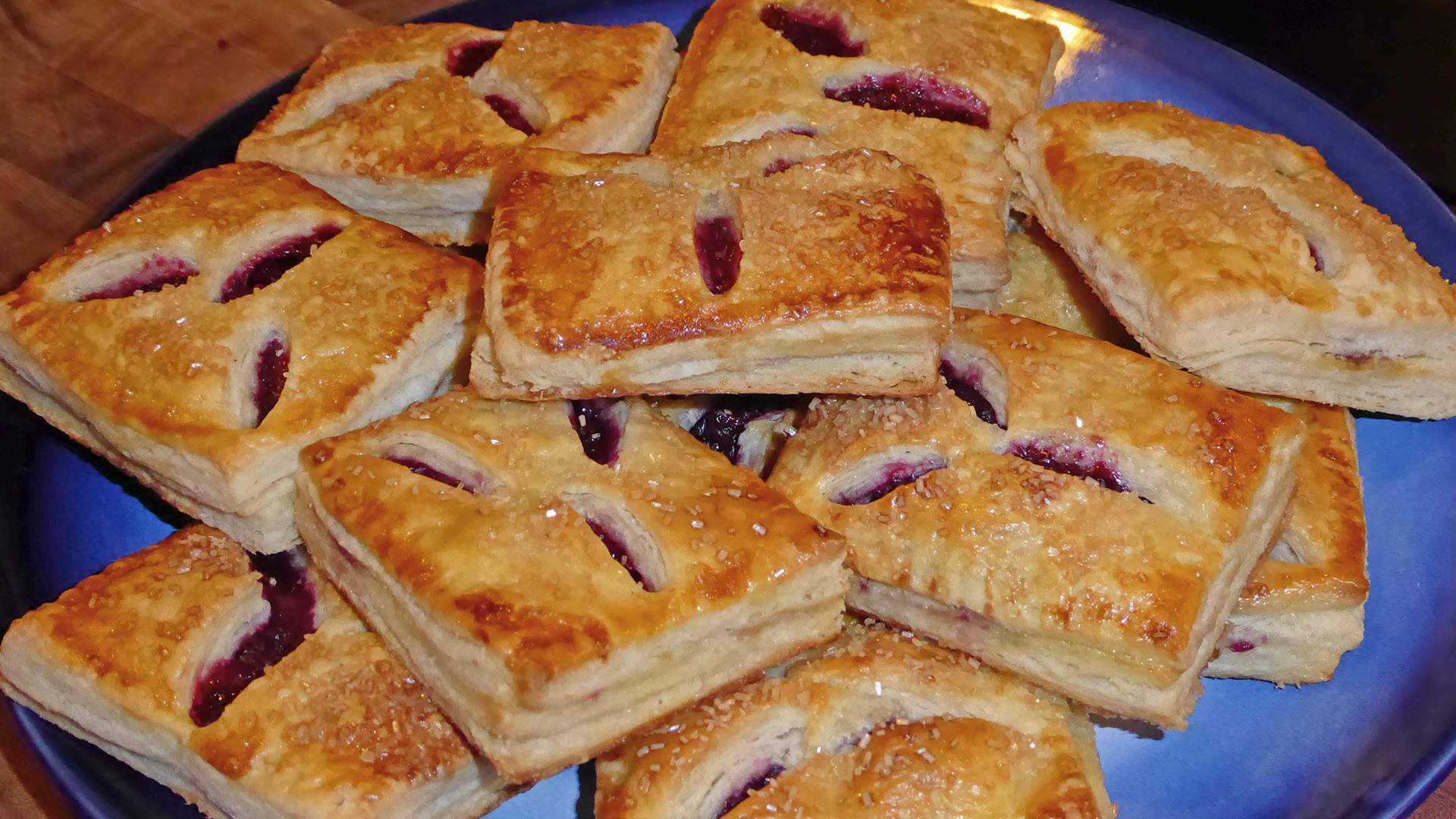Back in July, I noted King Arthur Flour’s blog entry for blueberry hand pies, and finally got around to making a blackberry version this past weekend. Then I made a bunch more Monday night to bring in to work – the results pictured above – with some adjustments that made them noticeably better. Foremost, I did four turns of the rough puff pastry instead of just the two called for in the recipe. That added only an extra half-hour of chilling and five or six more minutes of pounding/rolling/folding, and it was worth every minute.
A friend I shared them with on Sunday had been looking for a fairly simple puff pastry recipe and asked for this one, so I sent her the link and my notes, that email pasted under the line here. I did all the “next time, I’m going to” things mentioned below for version 2 on Monday night and each of them paid off handsomely.
If puff pastry – even this simpler rough puff recipe – seems daunting to you, it isn’t. Scroll through their pictorial blog entry and you’ll see it’s pretty straightforward. I’ve wanted to try my hand at it ever since, some years ago, I saw the price on frozen puff pastry that’s made with actual butter – and quickly moved along, defensively clutching my money clip. Oooowee, that’s some profit! I should add that it wasn’t Pepperidge Farm Puff Pastry Sheets because theirs haven’t been within a country mile of even two molecules of butter. Strictly oils and high-fructose corn syrup in there, friends – not what you would call traditional.
There were more pies than people on Tuesday; inside an hour, only five or six crumbs were left on the platter. This recipe is going onto my frequently-made list.
Step-by-step on the King Arthur Flour Baking Blog:
The changes I made were to 1) switch to blackberries, cutting them in half cross-wise because they were big (though they’re more tart than blueberries, I specifically did not increase the sugar in the filling because I prefer lightly sweet desserts where the fruit has the leading role), 2) add a half-teaspoon of cinnamon to the berry mixture, 3) use Sugar in the Raw to sprinkle on top instead of sparkling sugar because that’s what I have, and 4) use Julia Child’s method for the egg wash: Add a half-teaspoon of water to the egg, mix with a fork, then strain into a small bowl using the fork to further mix in the strainer and get the liquid through. Slackening the liquid and straining out the chalazae – those protein strands that anchor the yolk to the top and bottom of the shell – makes it easier to apply the wash well; coverage can be a bit spotty otherwise. This is especially true of very fresh eggs, where the chalazae are larger and thicker.
Note that you can use salted butter. There’s about an eighth teaspoon of salt in one stick of salted, so just reduce the ¾ teaspoon salt in the dough to ½ teaspoon and you’re all set. You can also sprinkle the pies with regular granulated sugar instead of larger crystals after the final egg wash. I think it does need that little bit of sweetness on top.
Flour your work surface well but not excessively throughout and brush excess off the dough before folding each time. Based on how quickly the dough softened as I worked with it, next time I make them, at the last rollout, I’m going to shape into the final 14×14″ sheet, cut the 3½” squares, arrange them on parchment on a baking sheet, and put them back in the fridge for 20 minutes. Then I’ll take them out and assemble the pies while the dough is nice and firm and get them in the oven. In assembling, I’m going to use a lighter touch with the fork crimping of the edges to allow the sides to rise more. The filling is thick enough that it’s not really trying to escape, so that won’t result in breaches.
Based on some other rough puff pastry recipes that do more than the two turns this one features, next time I’m also going to add the step of two more turns, for a total of four, after the initial 30-minute chilling, then chill the dough a further 30 minutes before the final 14×14″ rolling. This will produce 81 layers instead of just 9 from two turns. Traditional puff pastry dough gets five or six turns, producing 243 or 729 layers, respectively.
Sour cream is used here as the liquid instead of the water used in traditional puff pastry for four reasons: 1) adds liquid with additional fat to the recipe (like butter & shortening or butter & lard), 2), adds acidity that reacts with the baking powder (which reacts to both heat and acid), 3) tenderizes the gluten in the flour for a more delicate texture, and 4) helps baked goods in general retain moisture so they’re not dry husks after a day. Not that there are going to be any of these left in 24 hours, mind you.

